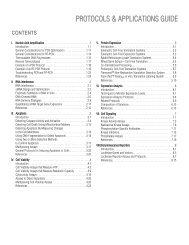2012 Promega catalogue
2012 Promega catalogue
2012 Promega catalogue
You also want an ePaper? Increase the reach of your titles
YUMPU automatically turns print PDFs into web optimized ePapers that Google loves.
Cell Signaling<br />
Anti-PARP p85 Fragment pAb<br />
Product Size Cat.# Price ($)<br />
Anti-PARP p85 Fragment pAb 50 µl G7341 539.00<br />
For Research Use Only. Not for Use in Diagnostic Procedures.<br />
Description: Poly (ADP-ribose) polymerase (PARP), a nuclear enzyme involved<br />
in DNA repair, is a well known substrate for caspase-3 cleavage during<br />
apoptosis. Anti-PARP p85 Fragment pAb is a rabbit polyclonal antibody<br />
specific for the p85 fragment of PARP that results from caspase cleavage of<br />
the 116kDa intact molecule and thus provides an in situ marker for apoptosis.<br />
The antibody is affinity-purified using a peptide that corresponds to a region<br />
of the p85 fragment of PARP. The PARP immunogen is a synthetic peptide,<br />
gly-val-asp-glu-val-ala-lys (GVDEVAK), representing the N-terminus of the large<br />
C-terminal fragment of human PARP that results from caspase-3 cleavage.<br />
Each batch of antibody is quality assurance tested for use in immunostaining<br />
applications and contains sufficient antibody for 50 immunocytochemical<br />
reactions at the suggested working dilution of 1:100.<br />
Features:<br />
• Immunogen: N-terminal peptide from p85 fragment.<br />
• Antibody Form: Affinity-purified rabbit polyclonal antibody provided in<br />
Dulbecco’s PBS.<br />
• Specificity: Specifically detects PARP p85 fragment in human, rat and<br />
bovine cells and tissues. Does not recognize the 116kDa intact PARP<br />
protein.<br />
Storage Conditions: Store at –20°C.<br />
Protocol Part#<br />
Anti-PARP p85 Fragment pAb Technical Bulletin TB273<br />
Anti-PARP p85 Fragment pAb and TUNEL double-labeling of apoptotic<br />
Jurkat cells. Cells were labeled with the Anti-PARP p85 Fragment pAb<br />
(red) and the DeadEnd Fluorometric TUNEL System (Cat.# G3250; green).<br />
The colocalization of cleaved PARP in cells containing TUNEL-positive nuclei<br />
demonstrates that the Anti-PARP p85 Fragment pAb specifically labels<br />
apoptotic cells. Protocols developed and performed at <strong>Promega</strong>.<br />
For complete and up-to-date product information visit: www.promega.com/catalog<br />
2734TA08_9A<br />
Anti-Human p75 pAb<br />
Product Size Cat.# Price ($)<br />
Anti-Human p75 pAb<br />
For Research Use Only. Not for Use in Diagnostic Procedures.<br />
200 µg G3231 579.00<br />
Description: The p75 neurotrophin receptor (p75 NTR ), also known as lowaffinity<br />
NGF receptor (LNGFR) and p75 LNGFR , binds nerve growth factor, brainderived<br />
neurotrophic factor, neurotrophin-3 and neurotrophin-4 with varying<br />
specificities. p75 NTR plays an important role in neurotrophic factor signaling<br />
including neuronal apoptosis. Anti-Human p75 pAb provides a valuable tool for<br />
understanding the role of p75 NTR in neuronal death.<br />
Features:<br />
• Immunogen: Cytoplasmic domain of the human p75 neurotrophin<br />
receptor.<br />
• Antibody Form: Purified rabbit IgG; 1mg/ml in PBS containing 50μg/ml<br />
gentamicin.<br />
• Specificity: Human, rat, mouse and chicken p75.<br />
Storage Conditions: Store at 4°C.<br />
Electron micrograph demonstrating immunostaining with Anti-<br />
Human p75 pAb in the inner molecular layer of the rat dentate gyrus.<br />
An axon terminal containing p75 immunoreactivity (A➤) is seen forming a<br />
synapse with a large unlabeled dendrite. Also labeled are a lengthwise axonal<br />
profile (B➤) and a small axonal cross section (C➤). Pre-embedding (Epon)<br />
immunohistochemistry was visualized with VECTASTAIN ® ABC Reagent.<br />
Myelin sheath appears black due to OsO 4 fixation. Image kindly provided by<br />
Drs. Karen Dougherty and Teresa Milner, Cornell University Medical College.<br />
2029TA01_8A<br />
173<br />
8<br />
Imaging and Immunological Detection<br />
Section<br />
Contents<br />
Table of<br />
Contents
















